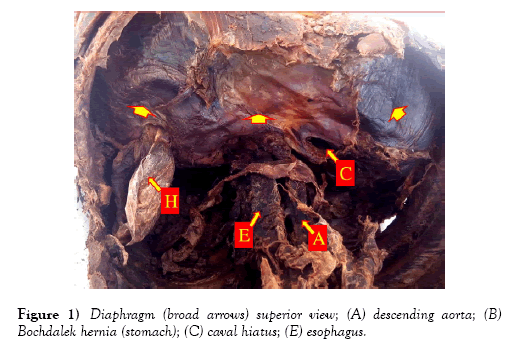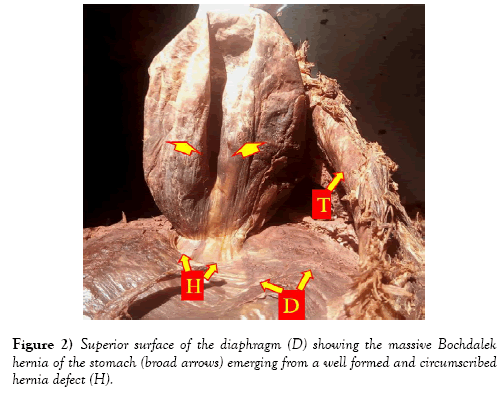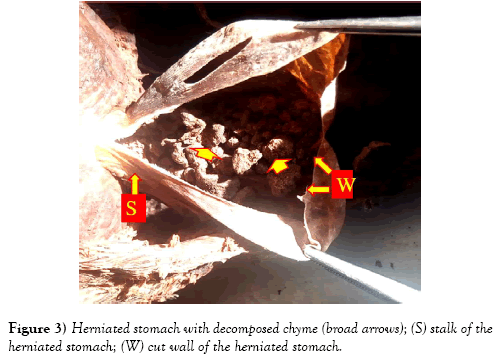A rare case of adult Bochdalek hernia in Tanzania: Presentation and review of the functional anatomy and embryological basis
Received: 06-Sep-2019 Accepted Date: Dec 10, 2019; Published: 17-Dec-2019, DOI: 10.37532/1308-4038.20.13.68
Citation: Russa AD. A rare case of adult Bochdalek hernia in Tanzania: presentation and review of the functional anatomy and embryological basis. Int J Anat Var. 2019;13(1): 68-70.
This open-access article is distributed under the terms of the Creative Commons Attribution Non-Commercial License (CC BY-NC) (http://creativecommons.org/licenses/by-nc/4.0/), which permits reuse, distribution and reproduction of the article, provided that the original work is properly cited and the reuse is restricted to noncommercial purposes. For commercial reuse, contact reprints@pulsus.com
Abstract
Congenital diaphragmatic hernias (CDH) are common and frequently fatal especially in neonates. In the adults they may cause no overt symptoms, but case of respiratory disorders is not uncommon. Globally, there is an enormous amount of clinical literature on CDH but in African the literature is scant and fragmented whereas the literature of anatomical and developmental significance is almost absent. The lack of African literature may entail a clue on the causation and genetics. The Bochdalek hernia is the most common type of all CHD Hernias. The present work reports a case of massive Bochdalek hernia observed during the cadaveric dissection classes of the medical students at the Muhimbil University of Health and Allied Sciences (MUHAS) in Dar es Salaam, Tanzania. The work examines the anatomical, developmental and clinical importance a black Tanzanian male cadaver presenting with a massive Bochdalek hernia case. We conclude that CDH may go undiagnosed while causing morbidity to the patients. We also review the literature on the causation, development and functional anatomy.
Keywords
Bochdalek; Hernia; Congenital; Adult
Introduction
Abdominal hernias are generally common and may be congenital or acquired. They occur into two directions: inferiorly via the pelvis, anteriorly via the abdominal wall and superiorly into the thorax. While the pelvic and abdominal wall hernias are easily detected and managed, thoracic hernias tend to be insidious and become noticeable when associated with overt symptoms. Anatomically the intrathoracic hernias are classified as hiatal (via esophageal heatus), anterior parasternal (via Morgagni openings) and Bochdalek hernia [1]. Due to the location of vital organs of the thoracic cavity, massive intrathoracic hernias tend be associated with severe complications and neonatal death. Small hernias may affect the lung, heart and vital vascular functions in the thoracic cavity. Majority of these cases are incidental, asymptomatic posterolateral diaphragmatic defects. While symptomatic Bochdalek hernias are rare in that adult, their occurrence may present signs of severe pulmonary distresses, cardiac and upper abdominal dysfunction [2]. In Tanzania, East Africa and indeed Africa at large, there is scant literature regarding the occurrence of Bochdalek hernias or any other congenital diaphragmatic hernias [3,4]. Globally, there is an enormous clinical literature on thoracic hernias but the gross anatomical literature based on cadaveric or postmortem studies are sketchy-which curtails the understanding of the structural and developmental aspects of the anomaly. In the present paper we report a rare occurrence of a massive Bochdalek hernia in an adult male cadaver otherwise died of unrelated disease condition. We also discuss possible basis of embryological development and functional implications of the hernia to the patient.
Case Report
During the dissection sessions of the medical students at the Muhimbili University of Health and Allied Sciences (MUHAS) we observed a massive case of stomach hernia permanently herniated and bulging into the thoracic cavity. The herniation occurred on the left posterolateral part of the diaphragm at the junction of the muscular part and the central tendon (Figure 1). Careful inspection noted that there were no other abdominal viscera such as intestinal loops, spleen or mesentery insinuating into the thoracic cavity (Figure 2). The defect opening was circular and circumscribed indicating a permanent structure from a congenital process. The pear shaped hernia measured about 8.5 cm in length and 4.6 cm in width and breadth each. Internally the herniated stomach contained chime remnants (Figure 3) indicating a normal digestion functionality during life. No other congenital anomaly was noted in the diaphragm, thoracic cavity, thoracic cavity or abdomen.
Discussion
Bochdalek hernia is a relatively common form of congenital diaphragmatic hernia (CDH) first described by Czech anatomist Vincent Alexander Bochdalek in 1848 [5]. Despite their relatively common occurrence there is scant literature in Africa. Whether the scarcity in the African literature is due to fewer incidences or simply the lack of detection and reporting, it remains to be elucidated. The present case occurred on the left side of the diaphragm which is in agreement with literature in which over 70% of all Bochdalek hernia cases occur on the left side part of the diaphragm [4,6] although a few studies have reported a right-sided predominance [7]. The defect in the present case did not affect the anatomy of the thoracic cavity as heart, lungs and other mediastinal organs all of which depicted a normal disposition. This could be explained by the fact that while the defect was formed early in life, the herniation of the stomach occurred much later after all the thoracic organs had been formed. The multiplicity of embryonic sources of the diaphragm may accelerate the increased occurrence of Bochdalek hernias. The diaphragm develops from four sources namely: the septum transversum ventrally, the pleuroperitenial membranes laterally, the esophageal mesentery dorsally and the body wall roundabout [8,9]. These four components fuse to form the adult diaphragm and any error in the morphogenesis and fusion thereof may produce a potential defect for herniation. The Bochdalek hernia may also form as a result of the intestines becoming permanently locked into the thoracic cavity during the diaphragm morphogenesis [10,11]. Based on its anatomical location, the Bochdalek hernia case reported in the present work seems to be a result of a failure in the fusion of the pleuroperitoneal membrane and the septum transversum.
Some studies have shown familial trends of cases [6] but a clear genetic predilection is still highly debatable-entailing that there could be some other factors such as environmental which can add to the occurrence of the condition. Studies have shown that Bochdalek hernias and other congenital diaphragmatic hernias are associated with some chromosomal aberrations such as aneuploidy, translocations, deletions, and marker chromosomes in about 30-34% of the cases with the abnormal chromosomal processes possibly affecting the mesenchymal structural development. It is understood that familial inheritance patterns of Bochdalek and other CDH are generally rare and occur at around 2% of detectable cases with autosomal recessive or dominant genes involved [12,13]. Studies employing hybridization methods for example have identified specific candidate genes NR2F2 and CHD2 on chromosome 15q26 [14-16]. Notably there are generally few cases of CDH in the African literature-a situation which can be attributed to low detection and reporting or less occurrence. For example, about 59 cases were reported in South Africa in a period of 13 years studied from 1984-1997 [17] and 8 other cases from Nigeria [18] which indicate that the frequency of occurrence may also be higher in other countries where no reports exist. Environmental and maternal life style factors such as alcohol use during pregnancy and pre-gestational diabetes have been identified as strong risk factors for CDH occurrence [19] which could otherwise explain a generally low occurrence of the anomaly in Africa especially in the Sub-Saharan countries where women for example are less likely to develop lifestyle-related diseases due to cultural norms. Empirical data from large studies, though, are needed to elucidate whether the low occurrence of the Bochdalek hernia in Africa is due to low reporting, poor diagnosis or whether the anomaly is less common among the black race for example.
Conclusion
Bochdalek hernia, like most other types of intrathoracic hernias is relatively common. Unlike other abdominal hernias, these hernias tend to be insidious in nature due to their deep body location and their presentations are usually diverse and present with significant morbidities and mortalities. Clinicians and particularly thoracic surgeons, gastroenterologist and radiologist should take into consideration probable occurrences of these hernias when considering the deferential diagnosis of chronic abdominal, respiratory and cardiac conditions.
Acknowledgements
I am indebted to Ismail Mkecha, Hamis Rajabu and Adamu Botea, prosector technicians in the Department of Anatomy at the University for the Preparation and demonstration of the case. I am also indebted to the MUHAS first year medical students who reported the case for detailed studies.
Conflict of Interest
None
REFERENCES
- Gidek E, Tucer M, Onat S, et al. A review of Morgagni and Bochdalek hernias in adults. Via Medica. 2011;70:5-12.
- Hamid K, Rai S, Rodriguez J. Symptomatic Bochdalek Hernia in an Adult. J Soc Laparoendosc Surg. 2010;14:279-81.
- Odelola M, Akinsulie A. Right sided hernia of Bochdalek: A case report. Niger J Paediatr. 2004;31:59-60.
- Ayane G, Walsh M, Shifa J, et al. Right congenital diaphragmatic hernia associated with abnormality of the liver in adult. Pan Afr Med J. 2017;28:70.
- Puri P, Wester T. Historical aspects of congenital diaphragmatic hernia. Pediatr. Surg. Int. 1997;12:95-100.
- Pober B. Overview of epidemiology, genetics, birth defects and chromosome abnormalities associated with CDH. Am J Med Genet C Semin Med Genet. 2007:145:158-71.
- Mullins M, Stein J, Saini S, et al. Prevalence of incidental Bochdalek's hernia in a large adult population Am J Roentgenol. 2001;177:363-6.
- Pansky B. Review of Medical Embryology 1st ed. Alameda, CA: Macmillan. 1982;48.
- Moore K, Persaud T. The Developing Human, Clinically Oriented Embryology 8th ed. Philadelphia: Saunders. 2008;151-3.
- Labbé A, Coste K, Déchelotte P. Congenital diaphragmatic hernia-mechanisms of pulmonary hypoplasia. Revue des Maladies Respir. 2011;28:463-74.
- Greer J. Current concepts on the pathogenesis and etiology of congenital diaphragmatic hernia. Respir Physiol Neurobiol. 2013;189:232-40.
- Veenma D, de Klein A, Tibboel D. Developmental and genetic aspects of congenital diaphragmatic hernia. Pediatr Pulmonol. 2012:47:534-45.
- Merrell A, Kardon G. Development of the diaphragm—a skeletal muscle essential for mammalian respiration. FEBS J. 2013;280:4026-35.
- Schlembach D, Zenker M, Trautmann U, et al. Deletion 15q24-26 in prenatally detected diaphragmatic hernia: increasing evidence of a candidate region for diaphragmatic development. Prenat Diagn. 2001;21:289-92.
- Hengstschlager M, Mittermayer C, Repa C, et al. Association of deletions of the chromosomal region 15q24-ter and diaphragmatic hernia: a new case and discussion of the literature. Fetal Diagn Ther. 2004;19:510-12.
- Klaassens M, van Dooren M, Eussen H, et al. Congenital diaphragmatic hernia and chromosome 15q26: determination of a candidate region by use of fluorescent in situ hybridization and array-based comparative genomic hybridization. Am J Hum Genet. 2005;76:877-82.
- Numanoglu A, Morrison C, Rode H. Prediction of outcome in congenital diaphragmatic hernia. Pediatr Surg Int. 1998;13:564-68.
- Abdur-Rahman L, Bamigbola K, Adeoye P, et al. Late presentation of congenital diaphragmatic hernia in Sub-Saharan Africa: A call for screening and prompt treatment. J Trop Med. 2016;18:1-5.
- McAteer J, Hecht A, De Roos A, et al. Maternal medical and behavioral risk factors for congenital diaphragmatic hernia. J Pediatr Surg. 2014;49:34-8.









